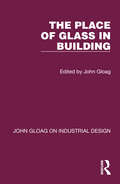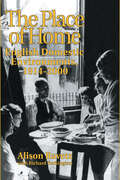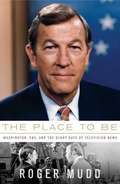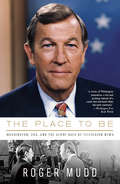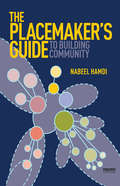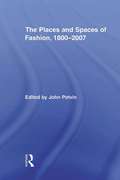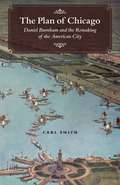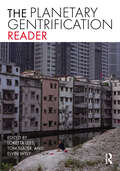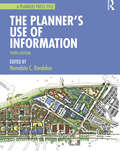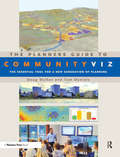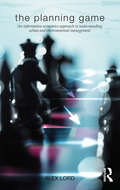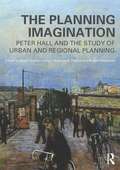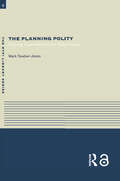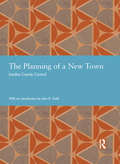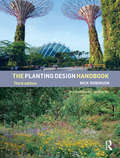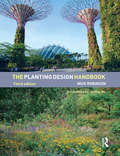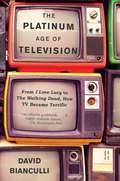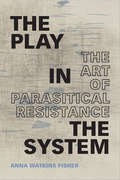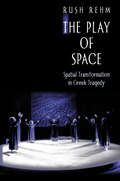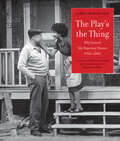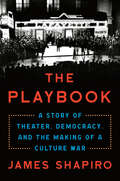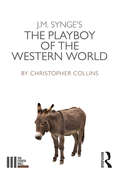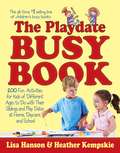- Table View
- List View
The Place of Glass in Building (John Gloag On Industrial Design Ser.)
by John GloagOriginally published in 1943, The Place of Glass in Building is a comprehensive and compact survey of the structural uses of glass in 20th Century architecture. It gives the facts about the physical properties, the possibilities and the limitations of the glass in common use. It also deals with the attributes of specialised and decorative glass and provides detailed descriptions of the principal types which were manufactured in the UK. Intended for architectural students it may also be of interest to architects, for it is a condensed survey of the progress that has been made in this structural and decorative material.
The Place of Home: English domestic environments, 1914-2000 (Planning, History and Environment Series)
by Alison Ravetz Professor Alison Ravetz R. TurkingtonA comprehensive and in-depth history of the 20th century English home, how it has been created, and how it works for people. It focuses on the various influences bearing on the development of domestic space since 1914 and covers both design and housing policy. Current debates from participation to co-operative housing are examined and several themes not previously brought together are linked, e.g. urban development/house design; technology at home/women and home; social meaning of home.
The Place of Many Moods: Udaipur’s Painted Lands and India’s Eighteenth Century
by Dipti KheraA look at the painting traditions of northwestern India in the eighteenth century, and what they reveal about the political and artistic changes of the eraIn the long eighteenth century, artists from Udaipur, a city of lakes in northwestern India, specialized in depicting the vivid sensory ambience of its historic palaces, reservoirs, temples, bazaars, and durbars. As Mughal imperial authority weakened by the late 1600s and the British colonial economy became paramount by the 1830s, new patrons and mobile professionals reshaped urban cultures and artistic genres across early modern India. The Place of Many Moods explores how Udaipur’s artworks—monumental court paintings, royal portraits, Jain letter scrolls, devotional manuscripts, cartographic artifacts, and architectural drawings—represent the period’s major aesthetic, intellectual, and political shifts. Dipti Khera shows that these immersive objects powerfully convey the bhava—the feel, emotion, and mood—of specific places, revealing visions of pleasure, plenitude, and praise. These memorialized moods confront the ways colonial histories have recounted Oriental decadence, shaping how a culture and time are perceived.Illuminating the close relationship between painting and poetry, and the ties among art, architecture, literature, politics, ecology, trade, and religion, Khera examines how Udaipur’s painters aesthetically enticed audiences of courtly connoisseurs, itinerant monks, and mercantile collectives to forge bonds of belonging to real locales in the present and to long for idealized futures. Their pioneering pictures sought to stir such emotions as love, awe, abundance, and wonder, emphasizing the senses, spaces, and sociability essential to the efficacy of objects and expressions of territoriality.The Place of Many Moods uncovers an influential creative legacy of evocative beauty that raises broader questions about how emotions and artifacts operate in constituting history and subjectivity, politics and place.
The Place to Be: Washington, CBS, and the Glory Days of Television News
by Roger MuddFamed journalist and broadcast anchor Roger Mudd recounts his days with CBS and how that news bureau operated during its heady days as a global information leader. From the congressional debate during the passing of the 1964 Civil Rights Act to Mudd's departure from CBS in 1980, he offers an insider's glimpse into the political events of the last half of the twentieth century with an informative, episodic narrative structure. Mudd offers equal doses of humor and meaning with each story of this memoir, which should appeal to anyone who has followed his career through the decades. Annotation ©2008 Book News, Inc., Portland, OR (booknews.com)
The Place to Be: Washington, CBS, and the Glory Days of Television News
by Roger MuddRoger Mudd joined CBS in 1961, and as the congressional correspondent, became a star covering the historic Senate filibuster debate over the 1964 Civil Right Act. Mudd was one of half a dozen major figures in the stable of CBS News broadcasters at time when the networkOCOs standing as a provider of news was at its peak. In "The Place to Be," Mudd tells of how the bureau worked: the rivalries, the egos, the pride, the competition, the ambitions and the gathering frustrations of conveying the world to a national television audience in thirty minutes minus commercials. It is the story of a unique TV news bureau, unmatched in its quality, dedication, and professionalism, that will highlight what TV journalism was once like and what itOCOs missing today.
The Placemaker's Guide to Building Community (Earthscan Tools For Community Planning Ser.)
by Nabeel HamdiFrom the author of Small Change comes this engaging guide to placemaking, packed with practical skills and tools that architects, planners, urban designers and other built environment specialists need in order to engage effectively with development work in any context. Drawing on four decades of practical and teaching experience, the author offers fresh insight into the complexities faced by practitioners when working to improve the communities, lives and livelihoods of people the world over. The book shows how these complexities are a context for, rather than a barrier to, creative work. The book also critiques the single vision top down approach to design and planning. Using examples of successful professional practice across Europe, the US, Africa, Latin America and post-tsunami Asia, the author demonstrates how good policy can derive from good practices when reasoned backwards, as well as how plans can emerge in practice without a preponderance of planning. Reasoning backwards is shown to be a more effective and inclusive way of planning forwards with significant improvements to the quality of process and place. The book also offers a variety of methods and tools for analyzing the issues, engaging with communities and other stakeholders for design and settlement planning and for improving the skills of all involved in placemaking. Ultimately the book serves as an inspiring guide, and a distillation of decades of practical wisdom and experience. The resulting practical handbook is for all those involved in doing, learning and teaching placemaking and urban development world-wide.
The Places and Spaces of Fashion, 1800-2007 (Routledge Research in Cultural and Media Studies #16)
by John PotvinThe Places and Spaces of Fashion, 1800-2007 brings together art, design, fashion, and a much neglected concern for its spatial realities. The spaces and places of fashion have often been overlooked in the writing of fashion history and visual culture. More often than not, however, these environments mitigate, control, inform, and enhance how fashion is experienced, performed, consumed, seen, exhibited, purchased, appreciated and of course displayed. Space, as this volume attempts to illustrate, is itself a representational strategy on par with and influencing the visibility and visuality of fashion. Innovative and challenging, the essays in this volume explore various physical and conceptual spaces, moving from physical environments to the two-dimensional with paintings, illustrations, and photographs to chart similarities, differences, and complex nuanced relationships between environments, fashion, identities, and visuality. The volume also navigates various sites (both permanent and temporary) of production, circulation, exhibition, consumption, and promotion of fashion that define meaning and knowledge about a culture or individual by providing for a bond between embodied consumers/spectators and fashion objects. The Places and Spaces of Fashion, 1800-2007 is a compelling project with a thematic, theoretical, and historiographic approach that is at once both focused yet far-reaching and original in its implications. The volume engages with questions attending to the ‘modern condition’ by seamlessly weaving interdisciplinary discussions of the visual with material culture to explore the spatial dimension(s) of fashion. Some of the essays explore new and exciting spaces while others offer compelling revisionary analyses of relatively known sources
The Plan of Chicago: Daniel Burnham and the Remaking of the American City
by Carl SmithArguably the most influential document in the history of urban planning, Daniel Burnham's 1909 Plan of Chicago, coauthored by Edward Bennett and produced in collaboration with the Commercial Club of Chicago, proposed many of the city's most distinctive features, including its lakefront parks and roadways, the Magnificent Mile, and Navy Pier. Carl Smith's fascinating history reveals the Plan's central role in shaping the ways people envision the cityscape and urban life itself. Smith's concise and accessible narrative begins with a survey of Chicago's stunning rise from a tiny frontier settlement to the nation's second-largest city. He then offers an illuminating exploration of the Plan's creation and reveals how it embodies the renowned architect's belief that cities can and must be remade for the better. The Plan defined the City Beautiful movement and was the first comprehensive attempt to reimagine a major American city. Smith points out the ways the Plan continues to influence debates, even a century after its publication, about how to create a vibrant and habitable urban environment. Incisively written, his insightful book will be indispensable to our understanding of Chicago, Daniel Burnham, and the emergence of the modern city.
The Planetary Gentrification Reader
by Loretta Lees Tom Slater Elvin WylyGentrification is a global process that the United Nations now sees as a human rights issue. This new Planetary Gentrification Reader follows on from the editors’ 2010 volume, The Gentrification Reader, and provides a more longitudinal (backward and forward in time) and broader (turning away from Anglo-/Euro-American hegemony) sense of developments in gentrification studies over time and space, drawing on key readings that reflect the development of cutting-edge debates. Revisiting new debates over the histories of gentrification, thinking through comparative urbanism on gentrification, considering new waves and types of gentrification, and giving much more focus to resistance to gentrification, this is a stellar collection of writings on this critical issue. Like in their 2010 Reader, the editors, who are internationally renowned experts in the field, include insightful commentary and suggested further reading. The book is essential reading for students and researchers in urban studies, urban planning, human geography, sociology, and housing studies and for those seeking to fight this socially unjust process.
The Planets: Photographs from the Archives of NASA
by Nirmala Nataraj“Might be just the book to bring out your inner astronomer . . . over 250 pages of breathtaking images from the past 50 years of NASA’s space exploration.” —ParadePreface by Bill NyeThis magnificent volume offers a rich visual tour of the planets in our solar system. More than two-hundred breathtaking photographs from the archives of NASA are paired with extended captions detailing the science behind some of our cosmic neighborhood’s most extraordinary phenomena. Images of newly discovered areas of Jupiter, fiery volcanoes on Venus, and many more reveal the astronomical marvels of space in engrossing detail. Anyone with an interest in science, astronomy, and the mysteries of the universe will delight in this awe-inspiring guide to the wonders of the solar system.“As you turn through the pages, you’re hit with true moments of awe, photos that remind you the power of nature extends beyond our own planet.” —Houston Chronicle“Breathtaking pictures show the otherworldly magic of the solar system . . . The images are at once humbling and uplifting: Here in the black void of space is Saturn’s frozen moon, Mimas, white and pitted like a galactic golf ball; here is the tiny golden orb called Io, casting a shadow in a perfect inky circle on the marbled surface of Jupiter; here is the great sun, flames spurting from its surface like plumes.” —The Wall Street Journal“[A] gorgeous photographic tour of space . . . The collection is a remarkable reminder of how much has been learned about the planets over the past few decades, solving many mysteries yet introducing many more.” —Publishers Weekly
The Planner's Use of Information
by Hemalata C. DandekarFor more than 35 years, planners have depended on The Planner's Use of Information to help them address their information needs. While the ability to manage complex information skillfully remains central to the practice of planning, the variety and quantity of information have ballooned in the last two decades. The methods of accessing and handling information––although often ultimately easier and faster––require new technical savvy. At the same time, planners themselves, and the constituents they serve, have changed. This completely revised and updated third edition of this popular book will serve the new generation of planners who work in a world where social media, cell phones, community-embedded development, and a changing population have revolutionized the practice of planning. Edited again by Hemalata C. Dandekar, with chapters by leading experts in data collection, analysis, presentation, and management, The Planner's Use of Information empowers practitioners to use and address the impacts of twenty-first-century technologies. The book offers a range of methods for addressing many kinds of information needs in myriad situations. It is an invaluable day-to-day resource for practicing planners and an ideal classroom text for courses in planning communication and analytical methods. Illustrations, real-life examples, cartoons, exercises, bibliographies, and lists of online resources enrich the text.
The Planners Guide to CommunityViz: The Essential Tool for a New Generation of Planning
by Doug WalkerWhat does the future look like? Planners wrestle with this question daily as they strive to bring a community's vision of itself to life, in all its complexity. Here is an authoritative and accessible guide to a tool that combines 3-D visualization, data analysis and scenario building to let planners and citizens see the future impacts of a plan or development. The Planners Guide to CommunityViz is the first book to explain how to support planning projects with CommunityViz, GIS-based software that planners around the world are using to help decision-makers, professionals, and the public visualize, analyze, and communicate about development proposals, future growth patterns, and the outcome of particular plans or developments. It shows the planner which tools and techniques to use and how to use them for maximum effectiveness on planning projects large and small. Full of practical examples and case studies, the book shows how CommunityViz can enliven the comprehensive planning process from visioning, to public participation, to values mapping, to build-out analysis. Chapters show how to use CommunityViz to analyze zoning regulations, calculate the costs of community services, and evaluate development proposals requiring design review. In addition, it is applicable to transportation planning, natural-resource planning, land-development suitability assessment, and urban economic development analysis.
The Planning Game: An Information Economics Approach to Understanding Urban and Environmental Management
by Alex LordTrading information is an essential aspect of the negotiations that underpin planning practice across the globe. In this book, Alex Lord uses information economics to outline a way of thinking about these negotiations that places the strategies that actors in the planning game use at the heart of the debate. Dialogue between economics and planning theorists has been, until now, rare. Lord argues that information economics’ tool kit, game theory – including well-known examples such as the Prisoners’ Dilemma, the Stag Hunt game and Follow the Leader – offers an analytical framework ideally suited to unpacking planning processes. This use of game theory to understand how counterparties interact draws together two distinct bodies of literature: firstly the mainstream economics treatment of games in abstract form and, secondly, accounts of actual bargaining in planning practice from a host of international empirical studies. Providing a novel alternative to existing theories of planning, The Planning Game provides an explanation of how agencies interact in shaping the trajectory of development through the application of game theory to planning practice.
The Planning Imagination: Peter Hall and the Study of Urban and Regional Planning (Planning, History and Environment Series)
by Mark Tewdwr-Jones Nicholas A. Phelps Robert FreestoneKnighted in 1998 ‘for services to the Town and Country Planning Association’, and in 2003 named by Her Majesty Queen Elizabeth II as a ‘Pioneer in the Life of the Nation’, Peter Hall is internationally renowned for the breadth and depth of his studies and writings on urban and regional planning. For the last 50 years, he has captured and helped to create the ‘planning imagination’. Here the editors have brought together in five themes a series of critical reflections on Peter’s vast and diverse contributions. Those reflections are provided by colleagues familiar with his work. The five parts are devoted to Peter Hall’s breadth of academic work, covering the history of cities and planning, London, spatial planning, connectivity and mobility, and urban globalization. Finally, as a sixth part, the editors have asked Peter Hall himself to reflect on his career and the sources of his imagination. The story this book tells is not one of a singular, totally consistent theoretical and philosophical view elaborated over several decades. Rather it covers a set of views that necessarily admits signs of Peter’s inconsistency and imperfection over the years – the insights and imperfections that inevitably accompany the exercise of a nonetheless remarkably fertile, restless and inspiring planning imagination.
The Planning Polity: Planning, Government and the Policy Process (RTPI Library Series #Vol. 4)
by Mark Tewdwr-JonesPlanning is not a technical and value free activity. Planning is an overt political system that creates both winners and losers. The Planning Polity is a book that considers the politics of development and decision-making, and political conflicts between agencies and institutions within British town and country planning. The focus of assessment is how British planning has been formulated since the early 1990s, and provides an in-depth and revealing assessment of both the Major and Blair governments' terms of office. The book will prove to be an invaluable guide to the British planning system today and the political demands on it. Students and activists within urban and regional studies, planning, political science and government, environmental studies, urban and rural geography, development, surveying and planning, will all find the book to be an essential companion to their work.
The Planning of a New Town (Studies in International Planning History)
by London County CouncilThe publication of The Planning of a New Town in 1961 aroused remarkable interest. Its pages described a private new town, sponsored by the London County Council (LCC), to be built at Hook in Hampshire; a scheme that innovatively combined Garden City/New Town traditions with sensitivity to modern design. At its heart lay a multilevel and megastructural town centre intended to serve as a genuine focus for the gathering community, featuring shops and amenities placed on a pedestrian deck with cars and servicing beneath. The report itself proved extremely popular even though the New Town had fallen foul of political opposition at local and national levels and had been abandoned before any construction took place. It offers an insight into the flux of ideas that surrounded New Town development in the early 1960s. Analysing the world as it might have been not only identifies choices that were once available for shaping the built environment, it also often reveals once-cherished hopes and aspirations about how people might live in cities.
The Planting Design Handbook
by Nick RobinsonSince the first edition was published in 1992, Nick Robinson's The Planting Design Handbook has been widely used as a definitive text on landscape architecture courses throughout the world. It remains one of the few titles written by a practicing landscape architect and educator who is also a horticulturalist and accomplished plantsman, and which deals with the application of planting design on a large scale in landscape architecture and urban design projects. The Planting Design Handbook is distinctive for its elegant integration of an ecological approach with an understanding of visual and spatial composition. It emphasizes the role of vegetation layers and designed plant communities in complex and diverse plant assemblages for all kinds of sites and uses. This expanded and comprehensively updated third edition still provides a complete examination of principles and practice of design for public, institutional and private landscapes. It takes account of developments in theory and practice, especially in the use of perennials, and reflects a variety of media and approaches current in landscape architecture and design. All chapters have been revised and re-written to ensure updated references and new references have been added. Many new photographs of planting and projects around the world have been included, with examples of current professional drawings to illustrate the design process. It is generously illustrated, including a colour section and the beautifully detailed line drawings of the Chinese architect and painter Jia-Hua Wu.
The Planting Design Handbook
by Nick RobinsonSince the first edition was published in 1992, Nick Robinson's The Planting Design Handbook has been widely used as a definitive text on landscape architecture courses throughout the world. It remains one of the few titles written by a practicing landscape architect and educator who is also a horticulturalist and accomplished plantsman, and which deals with the application of planting design on a large scale in landscape architecture and urban design projects. The Planting Design Handbook is distinctive for its elegant integration of an ecological approach with an understanding of visual and spatial composition. It emphasizes the role of vegetation layers and designed plant communities in complex and diverse plant assemblages for all kinds of sites and uses. This expanded and comprehensively updated third edition still provides a complete examination of principles and practice of design for public, institutional and private landscapes. It takes account of developments in theory and practice, especially in the use of perennials, and reflects a variety of media and approaches current in landscape architecture and design. All chapters have been revised and re-written to ensure updated references and new references have been added. Many new photographs of planting and projects around the world have been included, with examples of current professional drawings to illustrate the design process. It is generously illustrated, including a colour section and the beautifully detailed line drawings of the Chinese architect and painter Jia-Hua Wu.
The Platinum Age of Television: From I Love Lucy to The Walking Dead, How TV Became Terrific
by David BianculliTelevision shows have now eclipsed films as the premier form of visual narrative art of our time. This new book by one of our finest critics explains--historically, in depth, and with interviews with the celebrated creators themselves--how the art of must-see/binge-watch television evolved. Darwin had his theory of evolution, and David Bianculli has his. Bianculli's theory has to do with the concept of quality television: what it is and, crucially, how it got that way. In tracing the evolutionary history of our progress toward a Platinum Age of Television--our age, the era of The Sopranos and Breaking Bad and Mad Men and The Wire and Homeland and Girls--he focuses on the development of the classic TV genres, among them the sitcom, the crime show, the miniseries, the soap opera, the western, the animated series and the late night talk show. In each genre, he selects five key examples of the form, tracing its continuities and its dramatic departures and drawing on exclusive and in-depth interviews with many of the most famed auteurs in television history.Television has triumphantly come of age artistically; David Bianculli's book is the first to date to examine, in depth and in detail and with a keen critical and historical sense, how this inspiring development came about.
The Play in the System: The Art of Parasitical Resistance
by Anna Watkins FisherWhat does artistic resistance look like in the twenty-first century, when disruption and dissent have been co-opted and commodified in ways that reinforce dominant systems? In The Play in the System Anna Watkins Fisher locates the possibility for resistance in artists who embrace parasitism—tactics of complicity that effect subversion from within hegemonic structures. Fisher tracks the ways in which artists on the margins—from hacker collectives like Ubermorgen to feminist writers and performers like Chris Kraus—have willfully abandoned the radical scripts of opposition and refusal long identified with anticapitalism and feminism. Space for resistance is found instead in the mutually, if unevenly, exploitative relations between dominant hosts giving only as much as required to appear generous and parasitical actors taking only as much as they can get away with. The irreverent and often troubling works that result raise necessary and difficult questions about the conditions for resistance and critique under neoliberalism today.
The Play of Space: Spatial Transformation in Greek Tragedy
by Rush RehmIs "space" a thing, a container, an abstraction, a metaphor, or a social construct? This much is certain: space is part and parcel of the theater, of what it is and how it works. In The Play of Space, noted classicist-director Rush Rehm offers a strikingly original approach to the spatial parameters of Greek tragedy as performed in the open-air theater of Dionysus. Emphasizing the interplay between natural place and fictional setting, between the world visible to the audience and that evoked by individual tragedies, Rehm argues for an ecology of the ancient theater, one that "nests" fifth-century theatrical space within other significant social, political, and religious spaces of Athens. Drawing on the work of James J. Gibson, Kurt Lewin, and Michel Foucault, Rehm crosses a range of disciplines--classics, theater studies, cognitive psychology, archaeology and architectural history, cultural studies, and performance theory--to analyze the phenomenology of space and its transformations in the plays of Aeschylus, Sophocles, and Euripides. His discussion of Athenian theatrical and spatial practice challenges the contemporary view that space represents a "text" to be read, or constitutes a site of structural dualities (e.g., outside-inside, public-private, nature-culture). Chapters on specific tragedies explore the spatial dynamics of homecoming ("space for returns"); the opposed constraints of exile ("eremetic space" devoid of normal community); the power of bodies in extremis to transform their theatrical environment ("space and the body"); the portrayal of characters on the margin ("space and the other"); and the tragic interactions of space and temporality ("space, time, and memory"). An appendix surveys pre-Socratic thought on space and motion, related ideas of Plato and Aristotle, and, as pertinent, later views on space developed by Newton, Leibniz, Descartes, Kant, and Einstein. Eloquently written and with Greek texts deftly translated, this book yields rich new insights into our oldest surviving drama.
The Play's the Thing: Fifty Years of Yale Repertory Theatre (1966-2016)
by James MagruderAn insider&’s spirited history of Yale Repertory Theatre In this serious and entertaining chronicle of the first fifty years of Yale Repertory Theatre, award-winning dramaturg James Magruder shows how dozens of theater artists have played their parts in the evolution of a sterling American institution. Each of its four chapters is dedicated to one of the Yale Rep&’s artistic directors to date: Robert Brustein, Lloyd Richards, Stan Wojewodski Jr., and James Bundy. Numerous sidebars—dedicated to the spaces used by the theater, the playwrights produced most often, casting, the prop shop, the costume shop, artist housing, and other topics—enliven the lavishly illustrated four-color text. This fascinating insider account, full of indelible descriptions of crucial moments in the Rep&’s history, is based in part on interviews with some of America&’s most respected actors about their experiences at the Rep, including Paul Giamatti, James Earl Jones, Frances McDormand, Meryl Streep, Courtney B. Vance, Dianne Wiest, and Henry Winkler—among many others. More than just a valentine to an important American theater, The Play&’s the Thing is a story about institution-building and the force of personality; about the tug-of-war between vision and realpolitik; and about the continuous negotiation between educational needs and artistic demands.
The Playbook: A Story of Theater, Democracy, and the Making of a Culture War
by James ShapiroA brilliant and daring account of a culture war over the place of theater in American democracy in the 1930s, one that anticipates our current divide, by the acclaimed Shakespeare scholar James ShapiroFrom 1935 to 1939, the Federal Theatre Project staged over a thousand productions in 29 states that were seen by thirty million (or nearly one in four) Americans, two thirds of whom had never seen a play before. At its helm was an unassuming theater professor, Hallie Flanagan. It employed, at its peak, over twelve thousand struggling artists, some of whom, like Orson Welles and Arthur Miller, would soon be famous, but most of whom were just ordinary people eager to work again at their craft. It was the product of a moment when the arts, no less than industry and agriculture, were thought to be vital to the health of the republic, bringing Shakespeare to the public, alongside modern plays that confronted the pressing issues of the day—from slum housing and public health to racism and the rising threat of fascism. The Playbook takes us through some of its most remarkable productions, including a groundbreaking Black production of Macbeth in Harlem and an adaptation of Sinclair Lewis&’s anti-fascist novel It Can&’t Happen Here that opened simultaneously in 18 cities, underscoring the Federal Theatre&’s incredible range and vitality. But this once thriving Works Progress Administration relief program did not survive and has left little trace. For the Federal Theatre was the first New Deal project to be attacked and ended on the grounds that it promoted &“un-American&” activity, sowing the seeds not only for the McCarthyism of the 1950s but also for our own era of merciless polarization. It was targeted by the first House un-American Affairs Committee, and its demise was a turning point in American cultural life—for, as Shapiro brilliantly argues, &“the health of democracy and theater, twin born in ancient Greece, have always been mutually dependent.&”A defining legacy of this culture war was how the strategies used to undermine and ultimately destroy the Federal Theatre were assembled by a charismatic and cunning congressman from East Texas, the now largely forgotten Martin Dies, who in doing so pioneered the right-wing political playbook now so prevalent that it seems eternal.
The Playboy of the Western World (The Fourth Wall)
by Christopher Collins‘I’m thinking this night wasn’t I a foolish fellow not to kill my father in years gone by.’ – Christy Mahon On the first night of J. M. Synge’s The Playboy of the Western World (1907) the audience began protesting in the theatre; by the third night the protests had spilled onto the streets of Dublin. How did one play provoke this? Christopher Collins addresses The Playboy ’s satirical treatment of illusion and realism in light of Ireland’s struggle for independence, as well as Synge’s struggle for artistic expression. By exploring Synge’s unpublished diaries, drafts and notebooks, he seeks to understand how and why the play came to be. This volume invites the reader behind the scenes of this inflammatory play and its first performances, to understand how and why Synge risked everything in the name of art.
The Playdate Busy Book
by Heather Kempskie Lisa HansonIn The Playdate Busy Book (previously titled The Siblings' Busy Book) authors Hanson and Kempskie have outlined 200 activities that all the kids can enjoy together (ages 3 months to 9 years). Each activity write-up includes ways for babies, toddlers, preschoolers, and school-age kids to join in the fun. As in other Busy Books, the activities range from arts & crafts, seasonal decorating, outdoor adventures, and imagination stretchers to making music, learning together, and rainy-day family fun.
